 |
 |
Chaos, Volvos and Pete
Chaos! Once a simple concept understood by most ancient Greeks, chaos has progressed to become a complicated concept understood only by certain mathematicians and scientists. It is the reason why, as explained by Jeff Goldblum, cuddly little puppy dinosaurs grow up to wreak havoc and carnage in the Jurassic Park movies. The frog DNA and Richard Attenborough's erstwhile flea circus were just bit players -- it was chaos that did it. Chaos is also the reason why a butterfly flapping its wings in South America causes us to see Honda ads on TV (look, Honda shelled out big bucks for that campaign, and what's this costing you? Bear with me!). As far as I can make out (not being a mathematician or a scientist), chaos can be translated for the layman as "Everything Causes Everything Else." Which, in explaining everything, explains nothing other than "if not for X, then Y would be different." Let's try a personal example to see how this works.
Starting the following year, great good fortune (which is what we call chaos when it smiles benignly) and my father's work took the family to Santa Barbara, California, for a number of summers. In 1962, Santa Barbara was an idyllic town where going to the beach meant parking in a dirt lot and strolling across Cabrillo Boulevard to the sand with a bottle of Coppertone.
Santa Barbara ("where the mountains meet the sea") has great conditions for old British sports cars: cool mornings and nights by which to roast your feet on transmission tunnels, sunny afternoons on which to dismantle and resurrect convertible tops, Which did not include the Volvo P1800s that we came across in increasing numbers. It simply didn't qualify as a sports car -- the top didn't go down, the exhaust didn't snarl, the wheels weren't removeable with mallets, and it sat up way too high off the ground. It looked like the end product of a collision between a Ferrari and a Ford Victoria, we thought.
And what a wreck it was (the car, not the marriage). The seatbacks lay at strange angles and were covered with beach towels, nothing electrical worked, the transmission howled, the motor was from a junked 544, the front of the body was smashed in, the hood was held shut with an old bungee cord, and the front wheels didn't quite want to point in the same direction. We could hardly afford rent, much less car repairs, and when Marsha got a job requiring a freeway commute, I gave her my Renault and took over the Volvo (at least the carbs looked familiar). I promptly set to work on it -- I bought a new bungee cord. For five years, the car's condition improved in microscopic increments, as did our financial situation, until we were able to move away from the city. One day, while driving the still smashed-in car down a rural road, I saw two 122s parked in front of a farm shed, and as I slowed down to take a look, the shed's proprietor emerged and waved at me. Not only was the shed full of 122 parts, but there were two more Amazons out back, and he was happy to unload whatever part I wanted for a pittance.
Chaos/fortune has smiled on the Volvo since that day. A BMW owner gave me an article from a European car magazine about ipd -- it's amazing what results when a steady paycheck and a catalog converge in time and space. A few years after that, a man stopped me in a parking lot to offer me, for free, the hulk-of-a-122 in his driveway. As it happened, the penalties on overdue tags were worth more than the car (I did snag a few parts before we called the junkman to haul it away), Which is why I am happy to see two old Volvos out front. And I think we've seen that my layman's translation of chaos works out pretty well. So, thanks a lot, Pete! Couldn't have done it without you, bro! Unless -- maybe there was a second butterfly in South America...
Return to the Top |
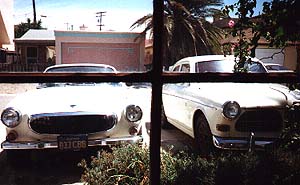 When I look out my front window, I see two Volvos in the driveway. This makes me very happy. Now, there's nothing strange in that, except that both Volvos are thirty-some years old. This makes me unusual -- only a tiny fraction of the world's population has a similar view from its front window. Perhaps you do, but the fact that you're reading this makes you special, too. So, how did this come to pass, anyhow?
When I look out my front window, I see two Volvos in the driveway. This makes me very happy. Now, there's nothing strange in that, except that both Volvos are thirty-some years old. This makes me unusual -- only a tiny fraction of the world's population has a similar view from its front window. Perhaps you do, but the fact that you're reading this makes you special, too. So, how did this come to pass, anyhow?
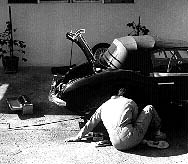 "If not for my brother Pete, then the view from my front window would be different." Pete is ten years older than me, and I idolized him when I was a kid -- he was doing all the things I someday hoped to do, like thinking girls were cute and not getting picked last when choosing up sides. One evening, during a summer working as a set builder for the Santa Fe Opera in New Mexico, Pete found himself floating down an arroyo with a soprano -- this is remarkable because they were in both a flash flood and a Renault Dauphine at the time.
"If not for my brother Pete, then the view from my front window would be different." Pete is ten years older than me, and I idolized him when I was a kid -- he was doing all the things I someday hoped to do, like thinking girls were cute and not getting picked last when choosing up sides. One evening, during a summer working as a set builder for the Santa Fe Opera in New Mexico, Pete found himself floating down an arroyo with a soprano -- this is remarkable because they were in both a flash flood and a Renault Dauphine at the time. They escaped through the sunroof, but not unscathed -- they married some years later. This is how the forces of chaos operate: my big brother goes to watch the submarine races, winds up competing in them, and my young mind gets imprinted with the notion that weird little foreign cars are more fun than my parents' Ford Sunliner.
They escaped through the sunroof, but not unscathed -- they married some years later. This is how the forces of chaos operate: my big brother goes to watch the submarine races, winds up competing in them, and my young mind gets imprinted with the notion that weird little foreign cars are more fun than my parents' Ford Sunliner.
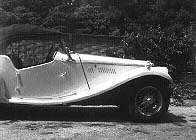 Today, those dirt lots are condos, crossing is done way down the road at a signal, and SPF24 sunblock is mandatory -- chaos has not been kind to the place. Anyway, those lots were full of sports cars; MGs, Austin Healeys, TRs, Jags, the odd Morgan, an AC Bristol, a smattering of Alfas and bathtub Porsches, and a tiny Crossley (there were no sports cars to speak of in Philadelphia, where we lived the rest of the year). Pete bought his first car: a cream-colored MG-TF with red upholstery.
Today, those dirt lots are condos, crossing is done way down the road at a signal, and SPF24 sunblock is mandatory -- chaos has not been kind to the place. Anyway, those lots were full of sports cars; MGs, Austin Healeys, TRs, Jags, the odd Morgan, an AC Bristol, a smattering of Alfas and bathtub Porsches, and a tiny Crossley (there were no sports cars to speak of in Philadelphia, where we lived the rest of the year). Pete bought his first car: a cream-colored MG-TF with red upholstery.
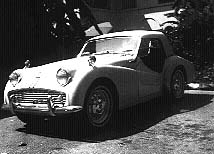 and, most of all, mountain roads like in movies of the French Riviera. In the course of many summers, I got to go along for a lot of rides in a succession of MGs, Triumphs and Healeys. We learned how to "check the tuning" of SU carbs by the sound of the exhaust slapping back at us from stone walls, we knew all about the decreasing radius of the blind off-camber turn in Sycamore Canyon, we referred to the S-turn on Montecito Street as the "chicane," and we always waved at other sports cars.
and, most of all, mountain roads like in movies of the French Riviera. In the course of many summers, I got to go along for a lot of rides in a succession of MGs, Triumphs and Healeys. We learned how to "check the tuning" of SU carbs by the sound of the exhaust slapping back at us from stone walls, we knew all about the decreasing radius of the blind off-camber turn in Sycamore Canyon, we referred to the S-turn on Montecito Street as the "chicane," and we always waved at other sports cars.
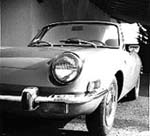 Well, years will pass, and chaos will have its way. Pete now lives in Georgia and drives a Ford Explorer. As for me, my first car was a Fiat 850, followed by a 124 Spider (I thought they were great -- Fiat does not stand for "Fix It Again, Tony"). I went through a number of (in retrospect) less interesting cars, moved to Los Angeles, and eventually married Marsha, an excellent woman who happened to own a Volvo 122S.
Well, years will pass, and chaos will have its way. Pete now lives in Georgia and drives a Ford Explorer. As for me, my first car was a Fiat 850, followed by a 124 Spider (I thought they were great -- Fiat does not stand for "Fix It Again, Tony"). I went through a number of (in retrospect) less interesting cars, moved to Los Angeles, and eventually married Marsha, an excellent woman who happened to own a Volvo 122S.
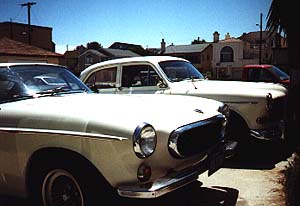 but it had a magazine in it that said "Volvo Sports America" on it. Club? There's a club? You know, it's interesting how the P1800 has become quite handsome with age...
but it had a magazine in it that said "Volvo Sports America" on it. Club? There's a club? You know, it's interesting how the P1800 has become quite handsome with age...